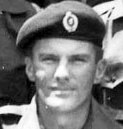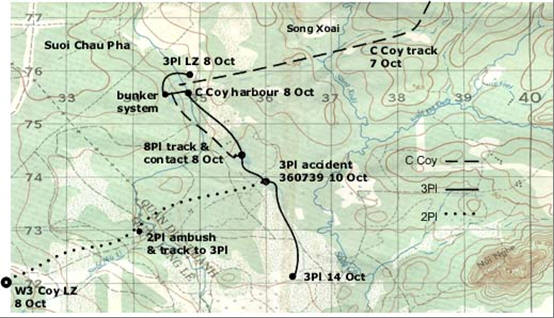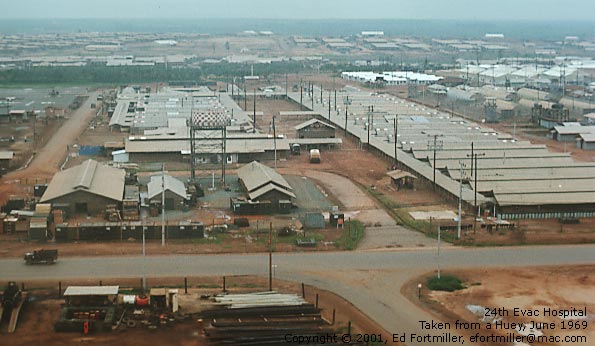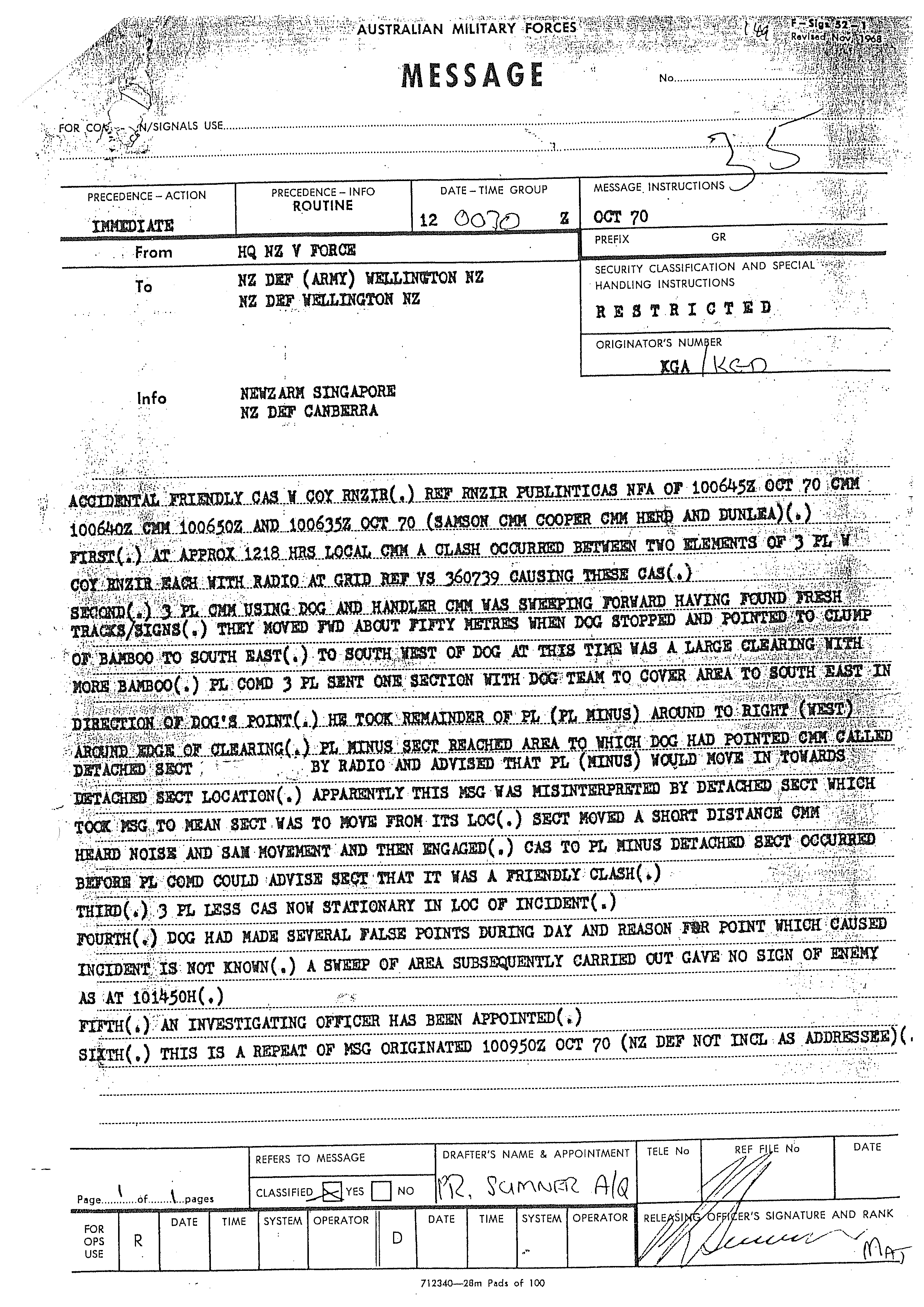11 October Capt Brown. Capt Brown returned to 3Pl at 8.30 AM 11 October to formally start work on the official investigation, W3 Coy HQ being advised of this intention at 8.20 AM. It was probably during this visit that some veterans recollect Capt Brown offering the opportunity to abandon the mission and be evacuated back to Nui Dat to recover. It is not clear if the offer was direct [does anyone want to leave the operation etc..?] or rhetorical [I have the option of returning you to Nui Dat…] but the veterans who recollect the offer also recollect that none of them now wanted to leave. Pte Hill recollects that he would have liked the opportunity to ‘have a beer and talk about it’ but doesn’t remember being offered that option. Tasking
Changed. At 8.54 AM CO 2RAR requested W3
Coy to clear and secure a LZ to allow the CO to visit W3 Coy HQ during the day. Then at 9.58 AM the command net exploded
with an urgent call to Maj Torrance to explain what was happening with W3 2Pl. Maj Torrance replied that 2Pl had married
up with 3Pl. CO responded ‘aren’t you aware that 3Pl was supposed to follow-up with C Coy 7Pl..?.’ Maj Torrance
replied ‘No’. CO 2RAR retorted that ‘3Pl was supposed to follow-up with 7Pl as discussed by Ops Officer last night’.
[there appeared to be confusion at Bn HQ over which W3 platoon was tasked which
may explain Maj Torrance’s denial]. There was
silence on the command net for 25 minutes but at 10.24 AM the war diary notes a conversation between the CO and Ops Officer:
‘there is some confusion on the task for W3 2Pl to complete. Maj Torrance’s intentions are to have 2Pl take over track
followed by 3Pl and do nothing of tracks followed by 7Pl. In which case mousetrap for W3 Coy not required. I want
an element of W3 Coy or C Coy to follow-up 7Pl findings ASAP’. At 10.26 AM a discussion between the Ops Officer Maj
Roberts, Maj Petersen and Maj Torrance decided that either 7 or 8Pl would follow-up the 7Pl track, the mousetrap for W3 Coy
was cancelled and that W3 2Pl, and 3Pl with their dog element c/s63A, were to move south 500 metres to avoid a possible clash. Maj Evan Torrance RNZIR Comment. Maj Torrance recollects “We were all hurting very badly at this time and I in particular was very angry that I had failed the Company and 3Pl in particular in letting operational direction slip out of our hands. I think I would have requested of the CO, Roy Taylor and Tan Roberts that they leave us to regroup and quietly set about to try and come to terms with our accident. There was no animosity or harsh words and they acceded to my request.” 3Pl W3 Coy. 3Pl did some minor local patrolling but most people remained within the perimeter and the platoon stayed in the same harbour for a second night. Capt Brown left the position by Sioux helicopter at 3.30 PM, possibly with CO 2RAR. 2Pl patrolled away from 3Pl to the south at some point during the day. HQ W3 Coy. At 6.50 PM Maj Torrance discussed with the Ops Officer two points: 1. That the dog team [c/s 63A] had done all they could and could be withdrawn 12 October, possibly on the MAINTDEM planned for the afternoon 12 October. This was agreed. 2. Maj Torrance wanted CO 2RAR views on Capt Bill Blair [2ic W3 Coy] taking over W3 Coy HQ while Maj Torrance spent ‘3 to 4 days’ with 3Pl. This was agreed and Capt Blair joined W3 Coy HQ during the afternoon 12 October so Maj Torrance and a radio operator could join 3Pl the following day. 12 October and After On 12 October W3 Coy including 3Pl received a MAINTDEM and then 3Pl resumed patrolling as if nothing had happened; by that night 3Pl were further south in the vicinity of YS365720. A visit by the 1ATF commander to the company was anticipated then cancelled. It is likely the 2RAR battalion 2ic Maj Roy Taylor RNZIR visited W3 Coy HQ and remained for the night. Maj Torrance and a signaller joined 3Pl the morning of 13 October. Maj Torrance recollects “I was with 3Pl for at least two days and recall patrolling with them (but well back in the line). The main aim was to convey to them my appreciation of their efforts prior to the accident, to support their leaders, to reassure everyone of my faith in their ability to continue to operate effectively, and to discuss the accident if they so desired. I can recall these days quite clearly because they were very different from normal routine and it was very wet and uncomfortable - particularly at night trying to keep dry, handle radio traffic, and keep as quiet as possible.” Map Showing all Movements 7 – 14 October 1970
Gone from Hat Dich. On 14 October W3 Coy was airlifted out of the flat ground and started operating in the Nui Toc Tien mountains [area YS3070] immediately SW of the W3 Coy HQ location. 3Pl had one further fleeting contact with VC on 19 October 1970 with no casualties on either side and was withdrawn from operations as planned on 27 October 1970 along with the remainder of W3 Coy. W3 Coy left South Vietnam on two flights by RNZAF C-130 Hercules on 10 November 1970, arriving in Singapore and rejoining the parent battalion 1RNZIR at Nee Soon Garrison. Within a short period of time the Company personnel had separated, most being repatriated to New Zealand, while others who remained for a further six months in 1RNZIR were mainly posted to different companies. The Company did not officially meet again until a reunion in Christchurch on Labour Weekend October 1989. Casualty Distribution. The US DUSTOFF helicopter initially flew all four casualties to ‘Vampire Pad’, the LZ at 1st Australian Field Hospital [1AFH] inside the 1st Australian Logistic Support Group [1ALSG] base in Vung Tau. All the casualties were assessed by the 1AFH triage team while still on the helicopter: Pte Tom
Cooper. Unconscious from a glancing
gunshot wound to the right side of his h Pte Ian
Herd.
Lcpl ‘Sammy’ Samson. Struck once in the right thigh from what was probably a 5.56mm M16 rifle round, ‘Sammy’ was hospitalised for a short period in 1AFH in a satisfactory condition. He was able to rejoin W3 Coy rear details in Nui Dat later in October, is standing in the 3Platoon photo taken in Nui Dat on 4 November, and returned to 1RNZIR in Singapore with the remainder of 3Pl. Sammy now lives in Sydney.
Pte
Ross Dunlea. Ross was admitted to 1AFH
with a gunshot wound over the right scapula [shoulder blade] with a small fragment penetrating the scapula. He
recollects that soon after being wounded someone in the Army in a confused state rang his mother to advise her that he was the
one who had been ‘shot in the head’. Ross required three operations to first excise dead flesh and any fragments that
were accessible [but 42 small fragments still remain in his shoulder and are visible by x-ray] and then twice to close the
open wound. He remained in 1AFH until 27 October and remembers being present during Ian Herd’s 2-hourly routine of being
rotated 180 deg, and the excellent support provided by Isabel Beaumont of the NZ Red Cross. When released Ross returned
to Nui Dat and was quartered with Cpl Baden Ewart NZ Component before he then completed his tour with V5 Coy RNZIR. Ross
left the Army in February 1972 and now runs a successful metal fabrication company in Kaikoura; although he likes to
positively look forward he continues to have health problems and suffers
US 24th Evacuation Hospital Long Binh [photo 24 Evac website]
Other Versions of the Accident This part illustrates how the accident has been incorrectly communicated: Pte Bill Hansen; on TOD in Saigon: Guy came into a bar in Saigon and told me Tom Cooper had been killed in an accident. I was told lots of Australians and Kiwis were working together, Australians had dogs on two big ropes as leads and the kiwi group went round behind a hill which cut out all radio transmissions. The Aussie dogs had picked up a scent and the Aussies just fired which is how Tom got killed. Definitely two dogs and a lot of Aussies, I never heard another version of the accident until this interview, we just never discussed the issue at all. Cpl Bruce Young; with 2Pl a short distance from the accident: 2Pl heard the bursts of fire; I remember we were quietly cheering our mates on while waiting nervously in case there were 3Pl casualties. I was told that half the platoon under the Pl Sgt was waiting in a line as fire support covering where the dog had pointed across the other side of a large clearing. The other half platoon was doing a wide flanking sweep around the clearing. The Pl Sgt element observed movement across the clearing where the dog had pointed. They tried to call the other element but radio comms had failed. Movement in the target area was engaged because it was thought the other flanking element could not have travelled around the clearing and got there so quickly. I also thought the casualties were caused because the sweep was in a line at right angles to the machine gun. Pte Ian Herd; during different interviews: Ian Herd has on several occasions, including an interview published in the New Zealand Herald prior to Parade 98, stated that he was located alongside Tom Cooper in 3Sect when the accident happened. This is most unlikely; the NCOs’ of both 1 and 3 Sections and others have placed him in 1Sect and firing the 1Sect machine gun at the start of the encounter. Those who tended Ian afterwards until he was evacuated are also able to place him some distance away from the 3Sect machine gun and Tom Cooper. After a briefing on the research detail, Ian was happy to acknowledge that he has garbled memories of the period and that the details he previously used were obviously in error. Fragments and Rumours: 1. One popular story has it that the contact front was initiated when black legs were seen lying behind a bush and what was thought were VC trousers was actually wet trousers from wading a stream on the approach to the accident site. However no participant can remember crossing a stream other than earlier that morning when first departing the night harbour location, and the contact was initiated by movement 20 or so metres away. Given that it was noon when the accident occurred the soldiers’ uniforms may have had a black appearance from being saturated with sweat or damp from pushing through the vegetation and this may have encouraged the story. 2. There was a story that the radio used by c/s53A had a faulty crystal. This was unlikely for two reasons: ANPRC-25 radio sets do not use ‘crystals’ for frequency tuning, and the fault was in appearance more likely a faulty or discharged battery. It is feasible that other issues were present at the same time; one hypothesis is that the frequency dial might have been knocked slightly off-centre when being dragged under the heavy undergrowth during the move and the whack with the machete blade released it back to the correct position. 3. After the accident there was comment in official reporting [see below] that Sgt Yandall had intended to move his part of 3Pl back to 2Sect’s location and that Cpl Glendinning had misunderstood this message. Other recollections have shown this sequence of events to be incorrect. Repeat of message first sent 10 October 1970 from HQ NZ V Force Saigon: an early attempt to explain the accident from [probably] NZ Component at Nui Dat, note important detail is updated by the research. [the message [msg] used military shorthand for brevity: 'cmm' means comma, 'hrs' means hours, 'publinticas' means public notification of casualty - for other abbreviations see the glossary]
© 2006 W3 Company website - www.w3vietnam.org.nz Part 4: Events Afternoon 10 October 1970 <<<< >>>> Part 6: Official Investigation and Conclusions |


![Tom Cooper [on right] with mates in the days before the last deployment of W3 Company](images/coop_harris_campbell_small.jpg)

 .
.
 from PTSD which went undiagnosed for some
years.
from PTSD which went undiagnosed for some
years. 